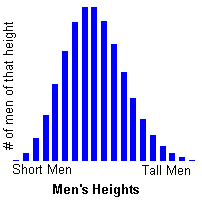Humans evolved in a world where babies and children often died
from disease and predators. Not long ago a new-born girl had only
one chance in three of living long enough to have a family of
her own. Modern technology, especially medicine, has increased
human survival rates and lifespan such that most babies live
long enough to have their own families.
Variation is the second important force in the theory of Darwinian
Evolution and it is most obvious to us among our own species.
There are dozens of different hair colours and many shades of
skin colour. A casual look around your town reveals people of
different heights and weights. People have different amounts of
muscle and strength, different artistic abilities and different
scholastic achievements. Some of these variations are due to environmental
influences and are thus acquired characteristics but those acquired
characteristics are never inherited. Much of the variation in
individuals is due to inherited characteristics.
On average, tall parents have tall offspring.
Note that I said "on average". There's some complex
genetics involved in height and environmental influences can also
play a part.
This graph shows the number of men of a certain height in a population.
(No numbers are given because it isn't important here.)
Notice the variation.
Most men fall within an average range but some men are very short
and others very tall. We say the "variation in height is
distributed".
A similar distribution of height would be found if the heights
of women were graphed. The average height for women would be smaller
but there would still be some women who were shorter than most
women and some women would be taller than the average woman. Indeed,
there would be some women taller than most men.
|  |
Variations like these are found throughout nature and at all levels
of detail.
A similar graph to the one above (its shape and similar distributions
of variation) is found when you tally up strength, intelligence
or number of children. This graph could also represent the distribution
of different enzyme activities found in a population, ability
to fit disease or red blood cell counts.
Almost every feature of an individual could be compared to the
same features in other individuals. If you did that comparison
you would find a distribution of extremes flanking an average.
Such variation is not restricted to humans. Similar variation
is seen in populations of all species - from oak trees to orangutans.
Much of the variation in a population is inherited. That does not mean
that offspring will have the exact characteristics as their parents.
(They seldom do because of complex genetics which we will not
go into here.) Instead, I mean that many of the characteristics
of an individual are passed on to the offspring. Those inherited
variations can continue being passed on from one generation to
the next.
There are rare instances in nature where two individuals are the
same - identical (or pretty close).
Think of an example of that before going on to the next page.
This work was created by Dr Jamie Love  and
and  licensed under a Creative Commons Attribution-ShareAlike 4.0 International License.
licensed under a Creative Commons Attribution-ShareAlike 4.0 International License.
If you like, you can return to the Home Page.

 and
and  licensed under a Creative Commons Attribution-ShareAlike 4.0 International License.
licensed under a Creative Commons Attribution-ShareAlike 4.0 International License.